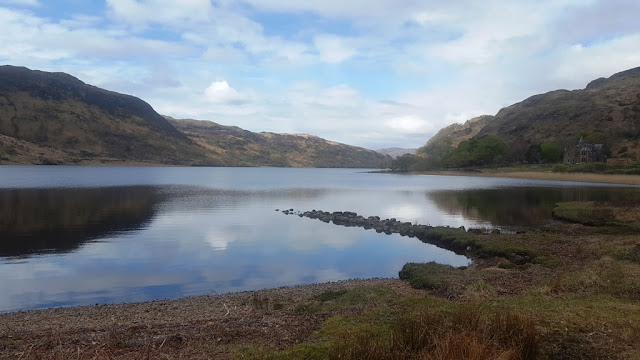Re-visiting old friends
Today was looking good weather wise so it was a good opportunity to get back down Loch Buie / Loch Uisg way and spend some time wandering looking at rocks! It was a while since I had been up at the area that formed a major part of my MSc so a bit of re-aquaiting was needed
The Gleann Beag Intrusion (as I referred to it) is unusual - it is picritic, very fresh, contains huge amounts of olivine, the olivine is highly magnesian, up to 91.5 % Forsterite and the rock in many places displays tremendous layering. There are other neat features as well as the pictures will show. On the BGS map, the intrusion is shown as a sinuous dyke of the Mull Swarm but there is more to it than that.
Anyway, here are a few pics of the trip. These are only a few of the total number of photos I took, just to give a flavour of what the rocks look like:
Loch Uisg, looking serene
Its a bit of a haul up by the Allt a'Bhacain Seilich but it gets you to the high ground of the Laggan Peninsula
Looking over towards the mainland from a high un-named tarn
This was the starting point for todays geologising - thats Ben Buie on the left and Creach Bheinn on the right. The Gleann Beag Intrusion starts at the heathery point on the far side of the lochan. It does not continue across (well I have never been able to find any trace of it)
Here's a close up of the rock, just near that heathery point in the picture above. Nice jointing, very rough surface. Some veining running through the joints in places
This shows the general appearance of the rock - a sort of brown colour, it stands out from the surrounding basalts. I had a piece of this outcrop sampled and sectioned for SEM work. Beautiful in thin section - olivines leap out!
This pock-marking is common along the intrusion, better developed in some places more than others. Unusual weathering pattern. I've seen this in other places explained as being due to weathering out of oikocrysts.
This picture shows the contact with the basalt country rocks quite clearly - the difference in both colour and texture is obvious - the basalt is grey, the picrite is brown
These pink veins are common cutting across the rock. Late stage felsitic material?
Some of the layering, especially in the middle section of the intrusion is impressive. A whole variety of layering styles can be found but this part here shows the most extreme - the darker bands are finer grained
This was just an experiment to take a close-up with a phone. Lots of rusty weathering of olivine on the weathered surface.
Just below the strongly layered section there is a zone of xenoliths. These look really obvious in the field. I have only found xenoliths in this one section - there dont appear to be any at other locations along the intrusion. Xenoliths are cognate - similar in composition to the main intrusion - very rich in olivine
And that was that - time to head on down and back to the car.
A nice view to finish with - looking over Loch Spelve














Comments